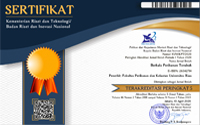CHEMICAL AND SENSORY CHARACTERISTICS OF CARP MEAT (Osphronemus goramy) FROM DIFFERENT SIZES
Abstract
Keywords
Full Text:
PDFReferences
Bahar B. 2003. Psanduan Praktis Memilih Daging Sapi. Jakarta: PT Gramedia Pustaka Utama.
BPS Provinsi Riau. 2016. Provinsi Riau Dalam Angka 2016. Badan Pusat StatistikProvinsi Riau. Pekanbaru.
Dwi, S. P. 2011. Pengaruh Tingkat Subtitusi Tepung Ikan dengan Tepung Maggot Terhadap Komposisi Kimia Pakan dan Tubuh Ikan Bandeng.Fakultas Ilmu Kelautan dan Perikanan. Universitas Hasanuddin. Makasar.
Estiasih, Teti, 2009. Minyak Ikan (Teknologi dan Penerapannya untuk Pngan dan Kesehatan). Graha Ilmu. Yogyakarta.
Hadiwiyoto, S. 1993. Teknologi Hasil Perikanan. Jilid I. Liberty. Yogyakarta. Kottelat , M., A.J. Whitten, with S.N.
Kartikasari and S. Wirjoadmodjo.1993. Freshwater Fishes of Western Indonesia and Sulawesi. Periplus Edition (HK), Jakarta.
KKP. 2016. Upi-Menengah-Besar. Kementrian Kelautan dan Perikanan Republik Indonesia. Diakses: 31 September 2018. http://kkp.go.id
Linder MC. 1992. Biokimia Nutrisi dan Metabolisme dengan Pemakaian Secara Kimia. Aminuddin P, Penerjemah. Jakarta: UI Press.
Ozogul Y, Ozogul F. 2005. Fatty acid profiles of commercially important fish species from.
Rasyad. F. 2011. Kajian profil asam lemak pada beberapa ikan air tawar hasil budidaya.Skripsi. Universitas Riau. Pkanbaru. 88 hal.
Sudarmadji, S, Bambang dan Suhandi,1997. Prosedur Analisis Untuk Bahan Makanan dan Pertanian.Li berti.Yogyakarta. 132.
Suprayudi MA, Setiawati M, Mokoginta I. 1994. Pengaruh rasio protein energi yang berbeda terhadap pertumbuhan ikan gurami (Osphronemus gouramy) [laporan penelitian]. Bogor: Fakultas Perikanan dan Ilmu Kelautan, Institut Pertanian Bogor.
Suwetja, I. K. 2011. Biokimia hasil perikanan. Jakarta, Media Prima Aksara.
Suzuki T. 1981. Fish and Krill Protein Processing Technology. London: Applied Science Publisher LTD.
Winarno. 1997. Kimia Pangan dan Gizi. Jakarta: PT. Gramedia Pustaka Utama.
Zaitzev, V.I, Lagunov. T, Makarova. I, Minder dan V, Podsevalov. 1969. Fish Curing and Processing. Mir Pulishers.Moskow.
DOI: http://dx.doi.org/10.31258/terubuk.47.1.118-125
Refbacks
- There are currently no refbacks.
Copyright (c) 2019 Guswanda Putra, Bustari Hasan, Sumarto Sumarto

This work is licensed under a Creative Commons Attribution 4.0 International License.












